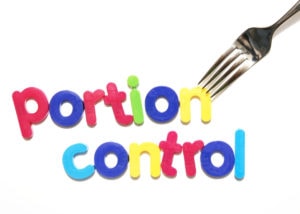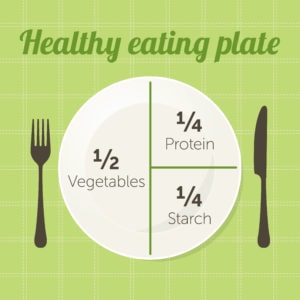 Portion control is one of the BIGGEST contributing factors when it comes to reaching your goals. Too much of anything is not a good thing.
Portion control is one of the BIGGEST contributing factors when it comes to reaching your goals. Too much of anything is not a good thing.
Proper portions mean proper balance of macronutrients and control of caloric intake. A portion – as opposed to a serving size, is the amount of food you actually eat in one sitting.
Most people are used to eating more than an allotted serving size of foods like bread, pasta, rice and meat. Fats and oils are also often eaten in quantities that exceed a serving just because few people bother to measure.
Watching your portion sizes can help you lose weight… and can mean the difference between success and failure.
The good news is that it’s a lot easier than you think! A lot of it comes down to what’s right in front of you when you sit down to eat.
Researchers in Australia studied 100 adults in a portion control study.
After educating the participants on “eating slowly” and eating only until they were full, the researchers gave one group a 600g portion of pasta and tomato sauce and the other group 350g of the exact same meal.
“Overall, the large-portion participants ate 34 percent more food than those given the smaller helping.”
This goes to show you that even if you’re educated and know how to eat slowly, most people will eat what’s right in front of them! So, the key here is to be mindful of what you put on your plate.
This coming week on my Facebook group I’m going to be setting a portion size challenge. To join the FREE challenge simply click here.
Here is what I want you to do for the next 7 days.
- Be mindful of what the actual serving sizes are for what you’re eating
- Measure and weigh your food until you have a solid idea of what a true portion looks like
- Use a smaller plate for your food or put less on a larger plate!
- Allow the vegetables to cover HALF your plate
- Practice eating slowly and listening to your body
- Eat until you’re about 80% full
If you want to trim down, minding your portion sizes is a simple way to cut calories, fat and carbohydrate intake. Here are the waistline-friendly portion sizes and the visual references that will help you estimate them correctly.
| Food Category | Ideal Portion Size | Visual Reference |
| Grains:
Rice, pasta etc. Bread Crackers Cereal |
40-60g 1 slice 2 no. 30-50g |
A small closed fist |
| Fat | ½ tbsp. | The tip of your thumb |
| Protein:
Men
Woman |
60g
45g |
Length and thickness of palm A deck of cards |
| Vegetables | Unlimited (unless starchy i.e. potatoes, parsnips etc. in which case use grain measurements) |
For Children:
For children, it is easier to think about servings. A serving is the size of your child’s hand in a fist.
Protein – your child needs at least one portion (one fist) of animal sourced protein a day or two portions of vegetable sourced protein a day as a minimum. Ideally aim for protein at all meals but especially lunch and dinner.
Carbohydrates – your child needs a portion at each meal, that’s one fistful of carbohydrate at breakfast, lunch and dinner.
Fat – up until age 3 your child needs more fat in proportion to their body weight than an adult needs. This equates to approximately 30-60g of fat per day for children up to 8 years, 50-80g for children up to 14 years and 60-100g for those over 14 years. It is recommended that full fat products be used up until age 3. After this you can opt for semi-skimmed versions and do not switch to low fat until around age 5.
Please remember that not all fat is equal in nutrients. Aim to have healthy fats such as oily fish, nuts, seeds and avocado.
And don’t forget the vegetables!
Your challenge this week is to be aware of your portion sizes and to focus on eating a little bit slower!
Are you up for the challenge this week!? Let me know in a comment on the Facebook group with your commitment!
Julie


Leave a Comment